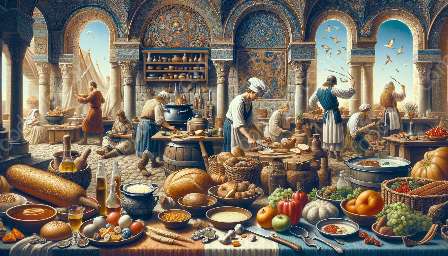The medieval Islamic world boasts a rich and diverse culinary heritage, characterized by an eclectic mix of flavors, ingredients, and cooking techniques. From elaborate feasts to daily meals, the food culture of this era offers a fascinating glimpse into the history of food and dining. Let's explore the enchanting world of medieval Islamic culinary practices, unveiling the unique traditions and influences that shaped the food culture of the time.
The City of Culinary Delights:
During the medieval period, cities such as Baghdad, Cairo, and Damascus flourished as centers of culinary innovation and excellence in the Islamic world. These urban hubs were home to bustling markets, where an array of spices, herbs, and exotic ingredients from around the globe were traded and used in cooking. The multicultural nature of these cities contributed to the fusion of culinary traditions, resulting in a vibrant and diverse food culture.
Spices and Flavors:
Spices played a central role in medieval Islamic culinary practices, adding depth, aroma, and exquisite flavors to dishes. Cinnamon, cardamom, saffron, and ginger were prized for their exotic allure and were used abundantly in both savory and sweet dishes. The use of spices was not only a matter of taste but also a reflection of social status and wealth, as rare and expensive spices were favored by the elite classes.
Cooking Techniques and Utensils:
The art of cooking in medieval Islamic culture was characterized by meticulous attention to detail and sophisticated culinary techniques. Both the wealthy and common people relied on an array of cooking methods, including grilling, stewing, and baking, to create a diverse range of dishes. The development of specialized utensils such as clay ovens, copper cookware, and intricate serving platters further exemplified the refinement and sophistication of culinary practices in the medieval Islamic world.
Feasts and Celebrations:
Feasting held a significant place in medieval Islamic society, serving as a means of displaying hospitality, generosity, and social status. Elaborate banquets and grand feasts were organized to celebrate important occasions such as weddings, religious festivals, and royal gatherings. These events showcased the opulence of medieval Islamic culinary practices, featuring an extensive array of dishes and delicacies that delighted the senses and symbolized the culinary prowess of the era.
Legacy and Influence:
The culinary legacy of medieval Islamic practices continues to influence modern food culture, leaving an indelible mark on the global culinary landscape. From the use of aromatic spices to the artful presentation of dishes, the traditions of the medieval Islamic world have shaped the way we perceive and experience food. By delving into the food culture and history of this era, we gain a deeper appreciation for the enduring impact of medieval Islamic culinary practices on the world of gastronomy.

